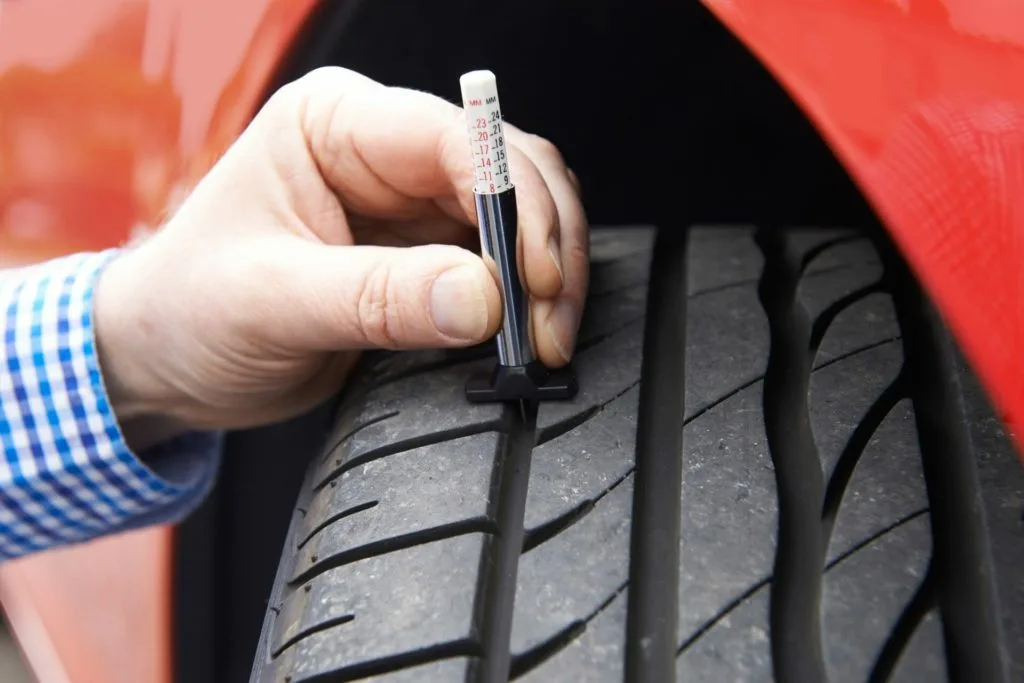Insert a penny into a tread groove with Lincoln’s head upside down. If you can see the top of Lincoln’s head, then your tread is less than 2/32″ and your tires have to be replaced. Another way to check is to look at the tread wear indicator bars located in the grooves around the tire.

- How do I know if my tires are in good condition?
- Determine whether you can see Washington’s entire head when the quarter is inserted into the tread groove. If a portion of Washington’s head is always covered by the tread, your tire has more than four thirty-second of an inch of tread depth remaining, which indicates your tires are still in good condition.
- What is the safest way to test a tire?
- They suggest using the quarter test instead, since the standard distance from the top of Washington’s head to the edge of a quarter is 4/32nds of an inch. If your tire’s tread is too shallow to be safe or you have other questions about your tires or tread, contact your nearest tire dealer.
- How do you measure tire tread depth?
- The most common of several methods for taking this measurement are: checking tread wear indicator bars, using the penny test, or measuring with a tire tread depth gauge. Whichever method you use, you need to check the tread depth at various points around the tire’s circumference.
- Where can I find the correct tire size?
- There should be a label there indicating the correct tire pressure and tire sizes. You can also check on the sidewall of the actual tires you have on the car now, it should be clearly printed on the side. Thanks! We’re glad this was helpful.
- How can I make my tires last longer?
How to: Make Your Tires Last Longer
- Check Your Tire Air Pressure Monthly. Take the easiest step to extend tire life: Maintain the correct air pressure. …
- Get Your Tires Rotated Every 5,000 Miles. In most cars, only one or two wheels “drive” the car at a time. …
- Have Wheels Balanced. …
- Check Your Alignment Twice a Year.
- What tests are done on tyres?
Tyre Related Tests
- Endurance Test.
- High Speed performance test.
- Rolling Resistance test.
- Plunger / Tyre Strength test.
- Bead unseat test.
- Radial, Lateral, Tangential, Cornering, stiffness Test.
- Digital Foot print test with pressure distribution.
- Dynamic growth test.
Should tyres be changed after 5 years?
A tyre needs to be typically replaced every 5 to 6 years, even if the tread is not worn out. This is done for the safety of the vehicle. However, the tyres and tread should be checked far more regularly to assess whether they need to be changed sooner or not.

- When should I replace my car tyres?
- Aim to replace your car tyres when the tread depth gets below 3mm and before it gets below 2mm. Find out more about the legal tyre tread depth. Tyres don’t usually last long enough to be replaced due to old age. Usually, the tyre tread wears down quicker than that. For older tyres, you can:
- How long do tyres last?
- In 5 years, your tyres will probably have been run over many different surfaces and perhaps have suffered shocks. After 5 years of use, have them checked by a professional at least once a year. This will ensure that they have not been damaged prematurely and that they do not endanger you or your passengers. Tyre DOT: how to tell tyre age?
- How often should a Bridgestone tire be replaced?
- Bridgestone recommends that tires more than 10 years old should be taken out of service and replaced with new tires. Be sure to check your spare tire and replace it if it is more than 10 years old, even if it appears new. In addition, Bridgestone recommends that all tires be regularly inspected and that inflation pressures be checked monthly.
- Do you need to replace tires with new tires?
- Be sure to install the new tires onto the rear axle for better control when driving on wet and winter roads. Ideally, you need to replace two tires with matching new ones. However, the most important thing is to install tires with similar performance features. For example, you should never put two high-performance tires with two touring tires.






